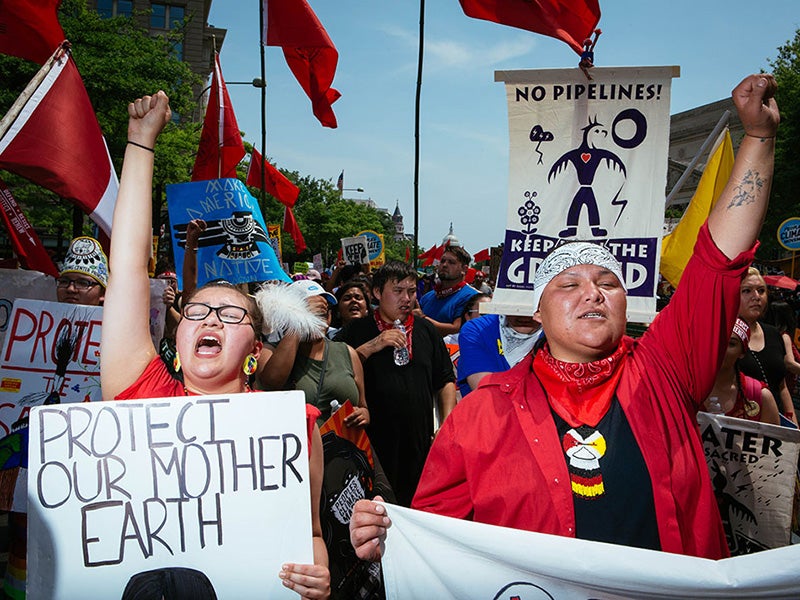Why We Marched
More than 200,000 people descended on the nation's capital to demand action on climate change. Here are a few of the thousands of reasons why they came, and why we must act now.

Photos and voices from the 2017 Peoples Climate March in Washington, D.C. More than 200,000 people descended on the nation’s capital to demand action on climate change. Here are just a few of the thousands of reasons why they came, and why we must act now.
Rose Whipple and Amber Cross, Minnesota:
“I’m marching because climate change is real. We have to show our government that the people have a voice and that we will continue to rise and fight for our Earth no matter what,” said Whipple.
Eve Tetaz, District of Columbia:
“You have to be the change you want to see in the world.”
Meeyoung Kim-Tawerilmal, Micronesia:
“Where I live, in Micronesia, sea rise is hurting my friends and family. So me and this little climate change activist are here because we have to act now. Climate change is happening.”
Stanley Morgan, Pennsylvania:
“All people, of all races and income levels, need access to healthy food, and climate change is challenging that. So, I’m marching for food justice.”
John Grossman, Massachusetts:
“I’m marching because climate change is an issue of justice for the working people of the world. I am here in solidarity with workers everywhere.”
Yudith Nieto, Texas:
“I am here to stand in solidarity with other fenceline communities who are impacted by the fossil fuel industry.”
Jade Bennett and Kayla Tavares, Florida:
“I am marching in support of renewable energy,” said Bennett. “And I’m here because Jade is so passionate about this. So, I’m marching for friendship,” said Tavares.
Myron Dewey, Nevada:
“This march is part of the much larger and older Indigenous-led movement that seeks to remind the people of the world to take care of the Earth, because it will then take care of us. I’m marching for those beliefs.”
Lindsay Michelle, District of Columbia:
“Hurricane Katrina showed us that black neighborhoods with the fewest resources have a harder time escaping, surviving and recovering from natural disasters. The fight for DAPL is still happening. These occurrences, and many others related to climate change, all affect people of color. We fight against climate change, because it affects us the most. People of color, I march for us!”
Robert Bank, New York:
“Many of the first victims of climate change are some of the poorest among us, so we are marching for justice for the poor.”
Selena Ramos, Minnesota:
“I am marching because everybody in the world—everybody—has the right to clean drinking water, beautiful trees, blue skies and to be able to see the animals in the wild.”
Shawn Williams, Maryland:
“I am marching because our communities of color suffer from the silenced issue of ‘environmental racism.’ Flint still does not have water, and my children are forced to drink and breathe toxics everyday. I am marching to remind the world that black and brown people are the most impacted by climate change.”
Jonathan Smith, New York:
“The politicians in Washington need to know that the people of America don’t support their climate policies.”
Sara Wescott, Wisconsin:
“We march for our children and their children, for those unborn and in honor of our ancestors who walked before us. We walk to create awareness.”
Zachary Sarantitis, Oden Gomez, Carl Biers, and Joey Biers-Browne, New York:
“We are marching because we don’t want the Earth to turn into one big desert,” said Gomez. “We are at the point where we need to take action now, and so we are taking action,” added Sarantitis.
Kiani Naranjo, Texas:
“I’m here to show solidarity with my brothers and sisters of all races who are being oppressed, and whose environments are being destroyed for corporate profits. I am here to let the government know that we have a voice and that we are saying that we will not take this anymore.”
Trip Van Noppen, California:
“I’m marching because I’m part of the resistance, in solidarity with so many partners and allies, and because I have great hope for our future.”
These are a few of the thousands of reasons why we marched in Washington, D.C. Were you in D.C. or did you join a sister climate march? If so, please share why you marched or why you believe that we must act now to address climate change.